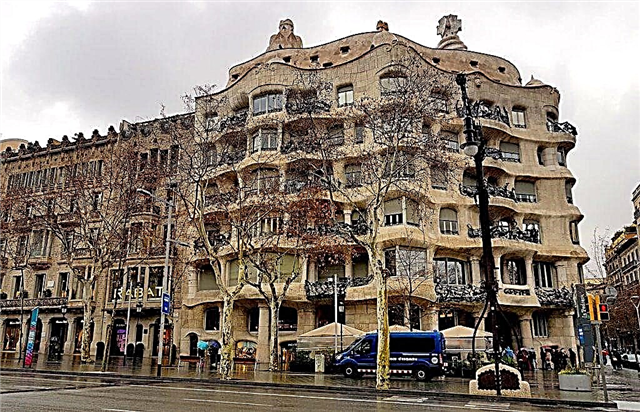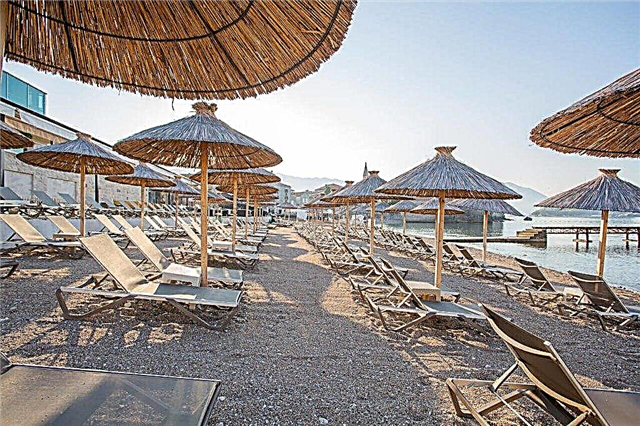Address: Russia, Yaroslavl region, Pereslavl-Zalessky, st. Left Embankment, 165
Build date: 1755 year
Coordinates: 56 ° 44'06.9 "N 38 ° 49'42.6" E
Cultural heritage site of the Russian Federation
Content:
A beautiful temple dedicated to the memory of the Forty Martyrs rises right near the mouth of the river and the shore of Pleshcheyevo Lake and is reflected in the waters of Trubezh. This place is very picturesque and is called the Rybnaya Sloboda. The original Baroque church building blends in perfectly with the local coastal landscape. And for more than two and a half centuries, it serves as a kind of beacon for fishermen on the lake.

The Sorokosvyatskaya Church from a bird's eye view
History of the construction of the Church of the Forty Martyrs of Sebastia
According to historical information, a wooden temple of the Forty Martyrs stood at the mouth of Trubezh since 1628. A little later, in 1652, a second church, consecrated in honor of the Intercession of the Most Holy Theotokos, appeared in Rybnaya Sloboda near the Sorokosvyatsky Church. There were 82 courtyards in her parish. By the 20s of the 18th century, both churches were badly dilapidated.
And the local priest Ivan Stefanov with the parishioners, with the permission of the authorities, by 1728 built two new wooden churches. The cold church began to be called Sorokosvyatskaya, and the warm one - Pokrovskaya.
In 1775, instead of these two wooden churches, a new one was erected, made of bricks. These were the heyday of stone church architecture. The newly rebuilt church in those days had about 200 parishioners. Since then, a tradition has been preserved in the Sorokosvyatskaya Church. Its cold throne is named in honor of the Forty Martyrs of Sebastia, and its warm throne is dedicated to the Protection of the Most Holy Theotokos.
The money for the construction of the temple was given by merchants from Moscow, brothers Maxim and Ivan Shchelyagin. They began their trade in Pereslavl, but later, like the merchants Obukhovs and Kholshchevnikovs, moved to the capital.
Feat of the Forty Martyrs
The history of the exploit of the early Christians, in whose honor the throne of this church was consecrated, is interesting and instructive. They were soldiers in the army of Rome. Events took place in 320 AD, when the detachment stopped near the city of Sebastia, in Lesser Armenia, which was then one of the Roman provinces. Now these lands are on the territory of Turkey.

According to the customs of that time, a sacrifice ceremony was to take place during a pagan holiday. The pagan Roman military leader Agricolaus decided that he would force 40 of his Christian warriors from Cappadocia to make sacrifices. But they disagreed.
And although in Rome since 313 the Christian faith was no longer under an official ban, Agricolaus locked the soldiers in prison and threats, and with promises sought them to renounce Christ. About a week of persuasion did not lead to any results.
Then Agricolaus commanded to lead the soldiers to the lake near Sebastia. It was winter. The Christians were stripped naked and forced to stand on the ice of the lake. In the morning they were icy, but still alive. Then the Romans killed them. The martyrdom of these faithless Christians has become a legend.
History of the Church of the Forty Martyrs of Sebastia in the XX century
By the beginning of the last century the walls of the temple were painted by the Pereslavl bourgeois V.P. Shemanaev... However, in the summer of 1919, a large fire broke out inside the building, which severely damaged the wall painting. She was almost completely covered with a layer of soot.
After the arrival of Soviet power, the church was run by the parish council. In 1922, the All-Russian Central Executive Committee decided to confiscate all church valuables to help the starving in the Volga region. The Metropolitan asked the priests and believers not to interfere with the authorities.

The commission for the confiscation of valuables came to the church, and priest Leonid Gilyarevsky with the parishioners presented her with two sets of liturgical utensils for the two existing church thrones. Only thanks to the efforts of the director of the Pereslavl Museum Mikhail Ivanovich Smirnov, the most valuable things - a silver censer and a 17th century Gospel framed in a silver setting - escaped confiscation and remelting, and became part of the museum exposition.
But the fate of M.I. Smirnova, like most people of that time, was not easy. In the 30s he was arrested, and he spent three years in the camps of the Turukhansk region. Later, this famous historian worked in Sergiev Posad.
The Sorokosvyatskiy temple remained in operation until the end of the 1930s and had about 150 parishioners. Then the church was closed, and the premises were first used as a library, then for locksmiths, and later for a rescue station. Divine services were resumed here in 1996.
The architecture of the Church of the Forty Martyrs of Sebastia
The Church of the Forty Martyrs of Sebastia is often called the Fourty. It looks best from the other bank of the Trubezh River, from the Right Embankment. At the beginning of the 20th century, a beautiful Vvedenskaya church stood here. And both of these temples made up a picturesque pair, framing the river mouth. But, unfortunately, only one of the two churches survived, on the left bank.

The basis of the Forty Martyrs Church is a traditional massive quadrangle crowned with five domes. Usually, on stone temples, four small domes were installed at the corners of the base. But during the construction of the Church of the Forty Martyrs, they acted differently, doing what was pleasant in wooden architecture. Smaller domes were installed on four pediments built on all sides. And from this the church acquired a picturesque and original look.
Compositionally, the building consists of three parts, which are connected to each other and extended in one line perpendicular to the river. This is the main temple with a semicircular apse, a one-story refectory and a high three-tiered bell tower with a high spire. It was added to the church later, in the 19th century.
Outside, the church is decorated in a very unusual way, and it immediately catches your eye. It has three-row window openings, the platbands on which differ from each other. The bell tower was built in the style of its time and also differs from the church itself in its external decoration. Its lower tier is decorated with rusticated walls. And the high arched openings of the two upper tiers are framed by strict semi-columns.
The church ensemble at the mouth of the Trubezh is very fond of artists and photographers. Since the bright red church colorfully contrasts with the white details of the window decoration and very harmoniously fits into the surrounding landscape.

The current state of the Church of the Forty Martyrs of Sebastia and the visiting regime
Now the church is active and is being actively restored. You can get into it on Saturdays from 7.00 to 20.00, and on Sundays and holidays from 7.00 to 15.00.
The icon of the Forty Martyrs of Sebastia with a particle of relics has become especially revered by all believers. The church celebrates temple and patronal holidays on March 22, Sunday 6 Easter, September 21 and October 29.
Next to the church there is a modern embankment with benches and lanterns, a small pier and a boat station. This is a favorite diving spot for local kids. At the mouth of the river there is an equipped descent to the water. The same staircase goes down to the lake. A very beautiful view of Lake Pleshcheyevo opens up from here - a real dream for photography lovers. However, photography is not allowed inside the church building itself.
How to get to the Church of the Forty Martyrs of Sebastia
The church in Pereslavl-Zalessky is located at the address: st. Left Embankment, 165. It is better to come here from the river, along a better road. If the path lies from Moscow, you need to turn left to the earthen rampart, onto Gagarin Street, drive along it to Levaya Naberezhnaya Street and go down to its mouth along the bank of Trubezh.

From the center of Pereslavl-Zalessky it is not difficult to walk to Rybnaya Sloboda on foot (1.5 km).On the way, you can see many houses, richly decorated with carvings. It is no coincidence that Rybnaya Sloboda is called the most picturesque part of Pereslavl. There are several bridges thrown across Trubezh, from which it is convenient to choose a convenient angle for photography.











